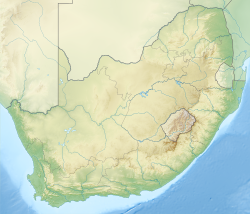| Bushveld Sandstone | |
|---|---|
| Stratigraphic range: Hettangian-Sinemurian ~ | |
| Type | Geological formation |
| Unit of | Stormberg Group |
| Lithology | |
| Primary | Sandstone |
| Location | |
| Coordinates | 22°48′S29°18′E / 22.8°S 29.3°E |
| Approximate paleocoordinates | 37°54′S4°42′E / 37.9°S 4.7°E |
| Region | Mpumalanga, Limpopo |
| Country | South Africa |
The Bushveld Sandstone is a geological formation dating to roughly between 201 and 189 million years ago and covering the Carnian to Norian stages. The Bushveld Sandstone is found in Transvaal, South Africa, and is a member of the Stormberg Group. As its name suggests, it consists mainly of sandstone. Fossils of the prosauropod dinosaur Massospondylus have been recovered from the Bushveld Sandstone. [1]
Contents
The Bushveld Sandstone was thought to be Late Triassic age, but was considered to be temporally correlative to the Clarens Formation by Smith et al. (1993). [2]

